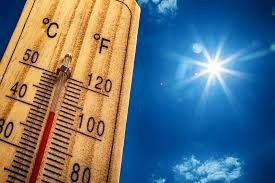
Temperatures are on the rise! It will soon be 90 with significant humidity. This can lead to “feels like” temperatures in the mid to high 90’s! Hot and sticky for sure. When the heat index creeps above 90 F, we are likely to see heat stress illness.
Early heat stress can be characterized as mild dehydration, sometimes referred to as heat exhaustion. In the hot weather and while exerting energy we use the fluids in our body in an effort to keep cool. We can loose a significant amount of those fluids leading to dehydration. One of the earliest symptoms reported by many dehydrated individuals is a headache. It often begins mild and gets progressively worse. As this happens the individual tends to become nauseated. Skin color can become pale and the skin may be damp. Skin temperature may be warm or cool, and the individual may actually complain of getting chills.
Individuals showing these signs and symptoms should be moved to a cooler area and any restrictive clothing removed. Oral rehydration should be attempted. Begin with small sips of water, especially if the individual is nauseated as gulping or chugging of water might cause vomiting. When providing oral rehydration, limit fluid to no more than one liter an hour. Excessive amounts of fluid in the stomach can actually slow down the emptying of the stomach and delay the absorption of the fluid.
Heat stroke is the most serious of the heat stress illnesses. This condition occurs when the compensation mechanisms of the body fail to maintain normal body temperature. The core body temperature can rise to between 104 to 107 F. Body temperature this high can cause damage to multiple organs including the brain. Other signs and symptoms may be similar to those of heat exhaustion. The main difference being that the individual with heat stroke usually will have an altered mental status such as delirium, confusion or even unresponsiveness. The individual experiencing heat stroke may also have a seizure. Many first aid manuals teach that the classic heat stroke patient will have red, hot, and dry skin which may not necessarily be the case. The classic red/hot/dry skin presentation is common with environmental heat stress. However, it is not unusual to see individuals suffering from exertional heat stress to present with pale, hot, wet skin.
Heat stroke is a potentially fatal medical emergency and must be treated promptly. Quick cooling is key to initial survival. Bring down the body temperature to around 101 F as quickly as possible. Cool water immersion is very effective. Water will take heat away from the body 25 to 30 times faster than air at the same temperature through a combination of conduction and convection. If cool water immersion is used, it is vital the victims airway and breathing is monitored and the patient’s head not be immersed as this becomes a drowning hazard. Other methods of cooling include spraying the individual with cool water along with fanning air across their body. Cool packs can be placed in junctional areas such as the groin and axilla and along the neck. Extremely cold and ice water should be avoided as it could stimulate vasoconstriction of the blood vessels of the skin causing retention of body heat.
It is important to watch for signs of heat stress and to remember that heat stress illness is not necessarily a continuum. It is possible for an individual who has been exerting a lot of energy to go straight to heat stroke without passing through early signs of dehydration and heat exhaustion. Stay cool, watch for signs of heat stress illness and be ready to act!
